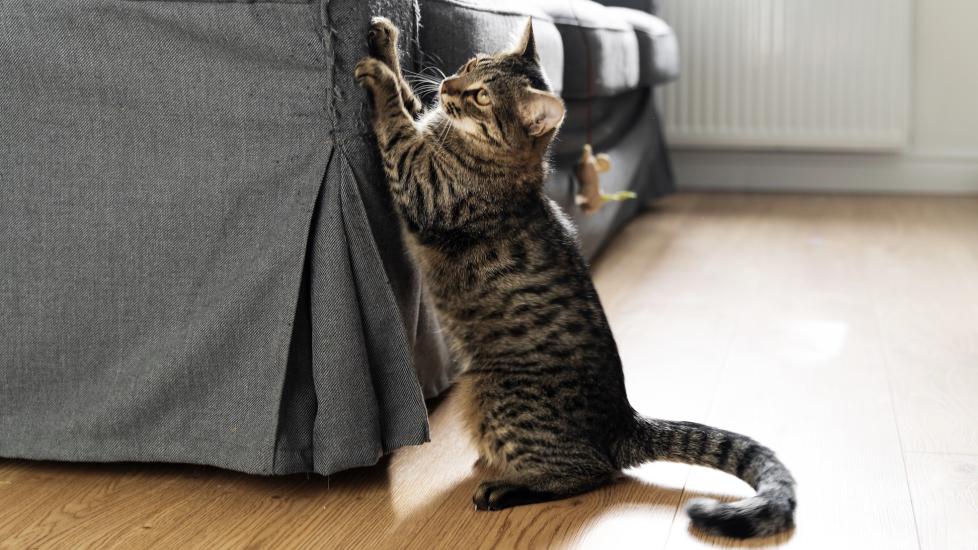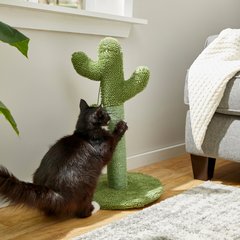How to Stop Cats From Scratching the Furniture
When cats scratch furniture, carpets, and other personal belongings, it’s often labeled an “inappropriate” behavior that must be corrected. However, scratching is a perfectly normal behavior for cats; it’s something they are genetically programmed to do.
A better term for scratching stuff around the house might be “undesirable” behavior. Undesirable scratching is best resolved by giving your cat a more suitable outlet for expressing this instinctual behavior.
If you can encourage your cat to scratch in their cat tree or cardboard scratchers, you can prevent your furniture, carpet, and personal belongings from becoming damaged. Here’s some insight on why cats scratch and how you can redirect this behavior.
Why Do Cats Scratch Furniture?
Like all normal cat behaviors, scratching is rooted in instinctive behavior that allowed the predecessors of today’s house cats to survive and thrive in the wild.
Scratching behaviors in cats start as early as 8 weeks of age. Scratching surfaces allows cats to mark their territory, both with the visual cue of torn material and the chemical cue of a pheromone released from scent glands in their feet. This pheromone contains information about a cat’s health, sex, and breeding status, which other cats can detect.
Cats also scratch to sharpen their nails, removing old material on the outer surface of the nail and exposing a new, sharp part of the nail underneath. Sharp nails allow cats to be effective hunters and to defend themselves from threats.
In addition, scratching allows a cat to stretch out fully and relieve muscle tension. The action of scratching also releases calming chemicals in the brain that help cats overcome feelings of anxiety and overexcitement.
In the wild, territorial scratching behavior most often manifests as scratching at upright tree trunks. This way, the visual cue of the torn bark is at eye level, and the chemical cue of the pheromone from the scent glands is at nose level for other cats.
In house cats, this preference for vertical surfaces means that the arms of couches and the legs of unvarnished wooden furniture may be common targets for territorial scratching. The fabric on the arms of couches rips easily, and unvarnished wood may splinter easily when scratched. As such, cats gravitate toward these materials.
Why Do Cats Scratch the Floor or Carpet?
Horizontal surfaces such as carpet may also be targets for scratching behavior in cats. They’re typically not as attractive to cats as vertical surfaces for marking territory because they are not at eye or nose level for other cats. However, horizontal surfaces may be appealing for stretching out, sharpening the nails, and relieving anxiety and overexcitement.
In addition, cats prefer to scratch at sturdy, immobile items. Carpet is usually held in place well, and it is soft enough for cats to sink their claws in fully, making it ideal for that purpose. Some cats also have individual preferences for horizontal over vertical scratching behaviors, and other cats may enjoy both.
Therefore, to stop the undesirable expression of scratching, it’s important to know if your cat prefers one way to scratch or both, so that you can implement the most effective solution.
How To Stop Cats From Scratching Couches and Other Furniture
The first step is to provide suitable alternatives that you can train your cat to prefer. Scratching posts are good tools for this. They should be tall enough to allow your cat to stretch out fully, and they should have a sturdy base to they don’t tip over, frightening or injuring them.
1. Find the Right Scratching Post Material
Each cat’s preference for scratching post material will vary, so pay close attention to your cat’s furniture-scratching behavior for clues. You may need to experiment with a variety of materials to determine what your cat prefers—upholstery fabric, sisal rope, carpet, wood, or cardboard.
The angle and position of the scratching post may also need to be adjusted to suit your cat.
For example, if your cat prefers sisal and scratching vertically, they may like the Frisco® by Chewy Cactus Cat Scratching Post.
If they prefer cardboard and scratching horizontally, they may like the Catit® Lounge Scratcher.
2. Put the Scratching Posts in the Right Places
Once you determine your cat’s preferred material, place the scratching post near their favorite furniture in an area where your cat and family members spend a lot of time. Cats are social creatures, so they prefer for their resources, such as food, water, litter boxes, and enrichment items like toys and scratching posts, to be placed somewhat close to other household members. Don’t hide a scratching post in a secluded area of your house if you want your cat to use it.
Some cats may like a scratching post near their bed, as they may want to scratch right after they wake up. With multi-cat households especially, providing multiple scratching posts can improve the chances of success in diverting scratching behavior away from furniture. Having multiple posts for cats also prevents fighting over resources.
It’s a good idea to place a scratching post near each item of furniture your cat likes to scratch so that they are always near a more suitable option.
3. Teach Your Cat To Use Scratching Posts
Once the scratching posts are in place, help encourage your cat to start using them instead of the furniture. It may be helpful to model scratching behavior for your cat by running your fingernails over the posts.
This creates an intriguing audiovisual demonstration for your cat so that they will want to come inspect the scratcher and try it out. Try sprinkling catnip on the post or giving your cat high-value treats or praise—whatever most motivates your cat—each time they use the scratching post instead of your furniture.
4. Keep Your Cat Away From the Furniture
Your cat must also be gently discouraged from returning to scratching furniture. One redirection technique is to set up motion-detection air spray cans near the furniture. These cans let out a hissing noise when the cat comes near. This can be helpful for interrupting furniture scratching, as long as the sound is not too prolonged or loud.
Prolonged or overly loud noises can increase fear and anxiety in cats, which is counterproductive for promoting desirable scratching behaviors. The goal is to quickly stop the undesirable scratching behavior, turn your cat’s attention to the new scratching post, and reward them for using it.
Here are some other tools for deterring cats:
-
Apply citrus-based sprays to furniture. Most cats dislike the smell of citrus.
-
Place double-sided sticky tape on furniture. Scratching at the tape feels unpleasant for cats without being painful.
-
Cover furniture with blankets or plastic sheets.
-
Use odor-neutralizing enzymatic cleaning products on your cat’s favorite pieces of furniture, because cats are drawn to scratch areas where they have previously deposited their scent-gland pheromones.
-
Try a pheromone spray like Feliway® Classic Calming Spray for Cats. Feliway Classic contains the feline facial hormone. Cats release this hormone when they rub their face against things to mark familiar surroundings. Cats naturally have an aversion to scratching where they have rubbed their face. When applied directly to the furniture that’s being targeted, Feliway Classic sprays can serve as another gentle deterrent to scratching behaviors.
-
Maintenance tasks such as regular nail trims and claw caps can also reduce furniture damage, but without proper outlets like scratching posts, they will not eliminate furniture scratching behavior.
5. Soothe Your Cat’s Anxiety
When scratching behaviors are excessive, there may be some anxiety at play. This can be addressed with calming supplements such as Purina® Pro Plan® Calming Care probiotic powder and medications such as fluoxetine (Prozac®) and sertraline (Zoloft®). Do not give cats the human-prescribed versions of these medications; you will need your vet to prescribe these to your cat.
6. Give Your Cat Plenty of Enrichment Activities
Offering sufficient enrichment to an anxious or bored cat may also help decrease excessive scratching. This may include purchasing cat trees for your cat to climb, providing perches by windows for your cat to view wildlife, increasing interactive playtime with your cat, teaching your cat to walk on a leash with a harness, and installing a “catio” so your cat can get some time outdoors in a protected enclosure.
7. Work With a Cat Behavior Specialist
Working with a Certified Applied Animal Behaviorist (CAAB) or a board-certified veterinary behaviorist may increase the chances of success in reducing excessive scratching behaviors. Your cat’s need to scratch will not be eliminated completely, but it can be controlled to a more desirable level by employing these medications, supplements, and behavioral modification techniques under the care and guidance of a veterinary professional.
How To Stop Cats From Scratching the Carpet and Flooring
Many of the same principles for managing vertical furniture scratching apply to horizontal surfaces such as carpet and other flooring. You may need to experiment with different horizontal scratching board materials that closely match the type of flooring your cat prefers to scratch.
Fabric-based (carpet) and cardboard-based scratching boards are often attractive to cats that prefer horizontal scratching because they tear easily, offer a satisfying scratch, and provide a clear visual cue to other cats.
Scratching boards should give your cat stability while they scratch and allow them to sink their claws into the material fully. Just like scratching posts, multiple scratching boards should be available in prominent, high-traffic areas of your home, close to areas with carpet or flooring that your cat likes to scratch.
Feliway Classic spray, enzymatic cleaners, and citrus sprays can all help deter your cat from scratching the carpet. You can then use high-value treats, toys, catnip, and praise to reward your cat for using the scratching board instead of the floor. Regular nail trimming and plastic nail caps are also useful for limiting damage to carpet and other flooring while you work on training your cat to prefer the scratching boards.
If your cat has underlying anxiety that’s causing excessive scratching of the floors, try working with a Certified Applied Animal Behaviorist or board-certified veterinary behaviorist. These trained veterinary professionals can help you find the calming supplements, medications, and behavioral modification techniques that work best for your cat.
Free video consult – ask our vet team anything about your new pet.
What Not To Do When Your Cat Scratches Furniture and Carpeting
There are a variety of things that you should not do when trying to prevent your cat from scratching furniture and carpeting.
Declawing Your Cat
Declawing—the removal of both the claw and the first toe bone—is an extremely painful procedure and one of the most drastic and harmful options for preventing damage to furniture and carpeting.
Scratching is a normal behavior in cats. Declawing does not change a cat’s drive to scratch. Instead, it only causes the cat frustration because they cannot perform an activity that is ingrained in them. The inability to express this normal behavior appropriately can lead to a cat becoming anxious and aggressive—to the point that your cat might start to bite.
Punishing Your Cat
Never punish your cat in any way for scratching. This includes loud and prolonged yelling, spraying them with water from a squirt bottle, and throwing things at or near your cat.
Punishment techniques create anxiety, increase the chances of fear-based aggression, and make your cat more likely to wait until you’re not at home to continue to scratch in an undesirable location.
The cat does not learn that scratching furniture and carpeting is inappropriate, but instead that they should avoid you while scratching these areas. Punishment techniques also threaten the bond you have with your cat.
Cats learn best when they receive a strong, positive response (a reward) for desirable behavior, while undesirable behaviors receive little to no response.
Forcing Your Cat To Use a Scratcher
Finally, your cat should not be physically forced in any way to use a new scratcher, such as placing their paws on the scratcher and dragging their claws along the material. Just as we would react, cats that are grabbed or subjected to physical contact against their will view this as a threat to their safety and survival. When you initiate unwanted physical contact with your cat, they may react with anxiety, fear, or aggression. This also endangers your bond with your cat.
Featured Image: Adobe/troyanphoto



